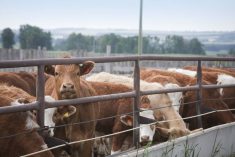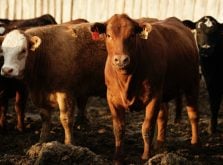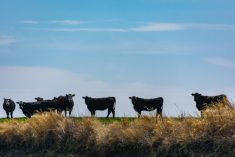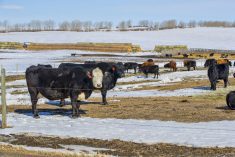Alberta fed cattle prices during November were averaging $385/cwt on a dressed basis, down $5/cwt from 30 days earlier. Live prices f.o.b. feedlot in southern Alberta were quoted in the range of $228/cwt to $230/cwt, the lowest since May.
The market has come under pressure as U.S. beef forecasts for the first half of 2024 have been raised from earlier projections. At the same time, consumer spending is declining as disposable income and savings decrease. In a normal year, monthly beef demand tends to make seasonal lows in January and February as everyone tries to lose five “holiday” pounds.
The fed cattle market is in a precarious situation because the U.S. economy is vulnerable to contraction in 2024. Canada is in technically in a recession with two quarters of negative growth. A weaker fed cattle outlook has weighed on the feeder market. At this stage, feeding margins will be deep in negative territory during the second quarter of 2024. The feed grain complex has potential to percolate higher in the spring as the market factors in a year-over-year decrease in U.S. corn acres and Canadian barley acres.
Read Also

Harvest wraps up and fall work begins
At the Eppich famly ranch in western Saskatchewan, the fall harvest was successful with few breakdowns, cows and calves have been sorted and a new tractor has arrived
In the November WASDE report (World Agriculture Supply and Demand Estimates), the USDA raised first-quarter beef production by 235 million pounds and second quarter output by 160 million. Beef supplies are not as tight as earlier anticipated. Keep in mind that beef demand is inelastic. A small change in supply can mean a large change in price, especially when the market is at extremes.
Feedlot placements in U.S. during September and October were higher than anticipated. Market-ready fed cattle supplies during the first half of 2024 will not be as tight as expected. Earlier in summer, the industry was expecting U.S. first-quarter beef production for 2024 to drop to 6.3 billion pounds but the USDA has continued to raise their forecast and the latest projection is 6.6 billion pounds.
Numbers exceed expectations
Alberta fed cattle basis levels weakened during November as market-ready supplies exceed year-ago levels. Feedlot placements in Alberta and Saskatchewan have also exceeded expectations. The Alberta fed cattle market has been functioning to encourage demand by trading at a discount to the U.S. Exports have not sufficiently increased to drain the excess supplies. A weak basis level environment will remain in place over the winter and weigh on Alberta feeding margins.
Feeder cattle prices have softened since last month but continue to trade near historical highs. In central Alberta, tan steers weighing 750 pounds averaged $348/cwt as of mid-November. Mixed steers around 500 pounds were hovering at the psychological $400/cwt level. The feeder market is functioning to encourage expansion. The U.S. beef cow slaughter for 2024 is expected to finish 500,000 head below 2023. This is sufficient to expand the calf crop in 2024. A marginal number of heifers will be held back for herd expansion, contributing to the year-over-year increase in the calf crop.
The U.S. and Canadian calf crops have been contracting since 2019. However, it’s very important to realize that this cattle rally over the past couple of years was largely due to growing beef demand. There was unprecedented monetary and fiscal stimulus during the COVID era which occurred from April 2020 through to the first quarter of 2022. This resulted in a surge in consumer spending and disposable income.

Market jolt coming in 2024
There is a significant fundamental shift in demand coming, which will occur in the latter half of 2024. The average U.S. and Canadian consumer has drained their savings. The money supply has been contracting and the average household has minimal if any disposable income. The cow-calf producer is in for a shock during the latter half of 2024. Canada is experiencing recessionary symptoms and the U.S. economic growth is projected to reach one per cent in 2024, down from an estimated 3.0 per cent in 2023. For 2024, the feeder market will be contending with larger supplies and lower demand, which results in lower prices.
The USDA baseline projection for 2024 had U.S. corn acres at 91.0 million, down 3.9 million acres from the 2023 acreage of 94.9 million. Canadian barley acres are expected to be down 10 per cent in 2024 compared to 2023. This lower seeded area comes on the heels of a year-over-year decline in Brazilian corn production. There is potential for a rally in the corn and barley markets next spring, especially if dryer conditions materialize. This could add further weight to the feeder market.
Beef production will be higher than expected during the first half of 2024, which will pressure fed cattle prices. Larger beef production comes at the same time as softer beef demand due to lower consumer spending. U.S. and Canadian cow-calf producers are in the process of expanding the herd, which will result in larger calf supplies in the latter half of 2024. The feeder market will be contending with growing supplies and decreasing demand causing prices to trend lower.
















